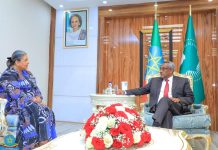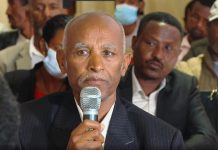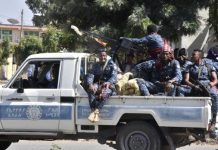Africa-Press-Ethiopia
The screams of the dying gradually fell silent as the sky darkened. Around midnight, Berhane Gebrezigher, an ethnic Tigrayan, remembers lying in a ditch full of men who, like himself, had been shot and left for dead. He called out: “Is there anyone breathing?”
When the sun rose, the old man faced a choice: die in the ditch or haul himself to the road. Painfully, he began shuffling upwards.
It was mid-January, more than two months into an ethnic conflict that has convulsed western Tigray, an area of rich farmland in Ethiopia’s north where two of the country’s ethnic groups – Tigrayans and Amharas – used to live and work the soil together.
Berhane, 74, says he was among more than 50 Tigrayan civilians rounded up and trucked by Amhara forces to the Tekeze River that bisects Tigray. The forces ordered the men to climb down into what appeared to be a freshly dug ditch, Berhane said. Then the gunmen fired. Berhane was hit in both legs and in the back; he said he lay among the bodies, listening to the men reload and shoot at anyone who moved.
Five Tigrayan witnesses told Reuters they saw dozens of dead.
The ethnic bloodletting by the river broke out amid a violent power struggle in Tigray – between the Ethiopian government of Prime Minister Abiy Ahmed and the region’s former rulers, the Tigray People’s Liberation Front (TPLF). Tigrayans are in the majority in their home region but make up less than 6% of the wider population. Amharas, the second biggest community in Ethiopia’s mosaic of more than 90 ethnicities and nationalities, lay claim to western Tigray as ancient Amhara land. Amhara leaders consider the Tekeze River a borderline between their territory and Tigray’s.
The first reports of ethnic atrocities in western Tigray surfaced two months earlier in mid-November, some 100 km to the west of the Tekeze River, in a farming town called Mai Kadra. Amharas said they’d been attacked by their Tigrayan neighbours. Tigrayans pouring into neighbouring Sudan said they’d been brutalized and driven out by Amharas.
The only thing the two sides agreed on was that hundreds died. Initial reports by human rights groups gave partial accounts of the violence. Yet with access to Tigray tightly controlled by Ethiopia’s government and phone lines down, it was almost impossible to make sense of the conflicting accounts put forward by the two communities.
But in March the government granted Reuters rare access to the region, where reporters saw burned out homes and hastily marked graves. Drawing on more than 120 interviews with Tigrayans and Amharas in Mai Kadra and other towns and villages inside Tigray, as well as in refugee camps in Sudan, they were able to build the first comprehensive chronicle of western Tigray’s descent into communal violence.
Reuters cross-checked the accounts it collected over the past six months with 44 unpublished testimonies gathered by two international aid organisations, medical records and satellite data. The timeline that emerges tells of two rounds of bloodletting in Mai Kadra and ethnic violence that spilled across western Tigray.
The first killings in Mai Kadra were committed by ethnic Tigrayans against Amharas, the reporting showed. Some were carried out by youths directed by a Tigrayan militiaman called Capt. Kassaye Mehar, said four Amhara witnesses. Reuters sent questions to Capt. Kassaye via the TPLF. TPLF spokesman Getachew Reda said of Kassaye, “I don’t know him.” He denied that the TPLF targeted Amhara civilians in Mai Kadra.
Then came revenge killings by forces from the Amhara region, which borders Tigray to the south and whose leaders back Abiy’s government. Tigrayan residents said the Amhara forces drove out Tigrayans, expunged Tigrayan names from street signs and seized Tigrayan homes, daubing some doors with letters in red paint: “This is an Amhara house.”
Amhara people took possession of Tigrayan farms – fertile lands they say were taken from Amharas during the decades of TPLF dominance. Reuters reporters saw fleets of minibuses packed with household goods and mattresses strapped to the roofs traveling from Amhara into western Tigray. New Amhara settlers were among the passengers.
In one majority Tigrayan town, called Division, Amhara forces burned many houses, Tigrayan witnesses said, leaving nothing for the Tigrayans who lived there to return to. Sensors aboard U.S. government satellites detected a series of potential fires in and around Division on Nov. 7, a Reuters analysis found.
The ultimate toll of this communal violence remains unclear. In Mai Kadra, at least 767 people were killed, according to two lists of victims – one Amhara, one Tigrayan – reviewed by Reuters.
Across the region, thousands are believed to have died in the wider war.
Professor Jan Nyssen from Belgium’s Ghent University is overseeing a project that tracks civilian deaths in Tigray by drawing on social media and witness reports, then cross checking the information with people who know the victims. He said his team has reports of more than 8,000 civilians killed and has identified 2,562 of these.
The ethnic violence is reverberating far beyond Tigray. Independent analysts say the fighting is threatening the unity of Ethiopia, Africa’s second-most populous nation. Amhara is seeking to formally annex the disputed land, equal to about a quarter of Tigray. Other regions in Ethiopia’s fractious federation are watching the government’s response carefully, mindful of simmering violence on their own disputed borders.
The Amhara regional government says it has taken control of western Tigray. Its representatives plan to resettle up to half a million Amharas there.
“There is no space called western Tigray, because this area is part of Amhara region,” the regional government’s spokesman, Gizachew Muluneh, told Reuters.
Western Tigray’s Amhara-appointed administrator, Yabsira Eshetie, said any accusation that Amhara forces killed Tigrayans “is groundless and far from reality.”
The United Nations has spoken of possible war crimes by all sides in Tigray’s war. US Secretary of State Antony Blinken said in March there have been acts of ethnic cleansing and called on Amhara forces to withdraw. In April, Reuters detailed accounts of women tortured and raped in central Tigray in conditions that a regional official described for the first time as “sexual slavery.”
Ethiopia’s government didn’t respond to detailed questions for this article. It has denied there has been “targeted, intentional ethnic cleansing.” In a speech to parliament on March 23, Prime Minister Abiy defended Amhara forces.
“Portraying this force as a looter and conqueror is very wrong,” he said. The government says reports of abuses are exaggerated, and where crimes have been committed they will be dealt with under the law.
Witnesses to the Mai Kadra killings and expulsions spoke of heroism and betrayal on both sides. While some townspeople gave refuge to neighbours belonging to the other ethnic group, others joined the killing, they said.






